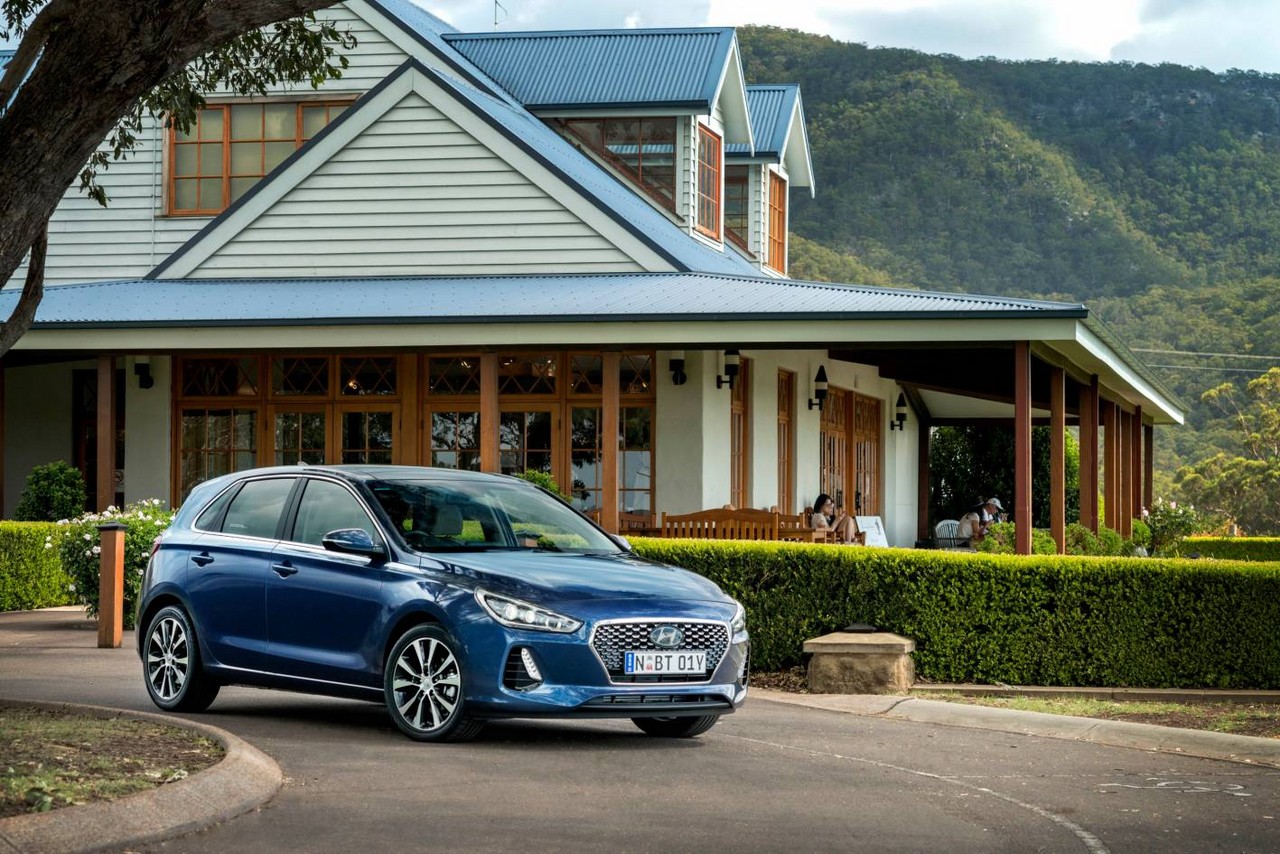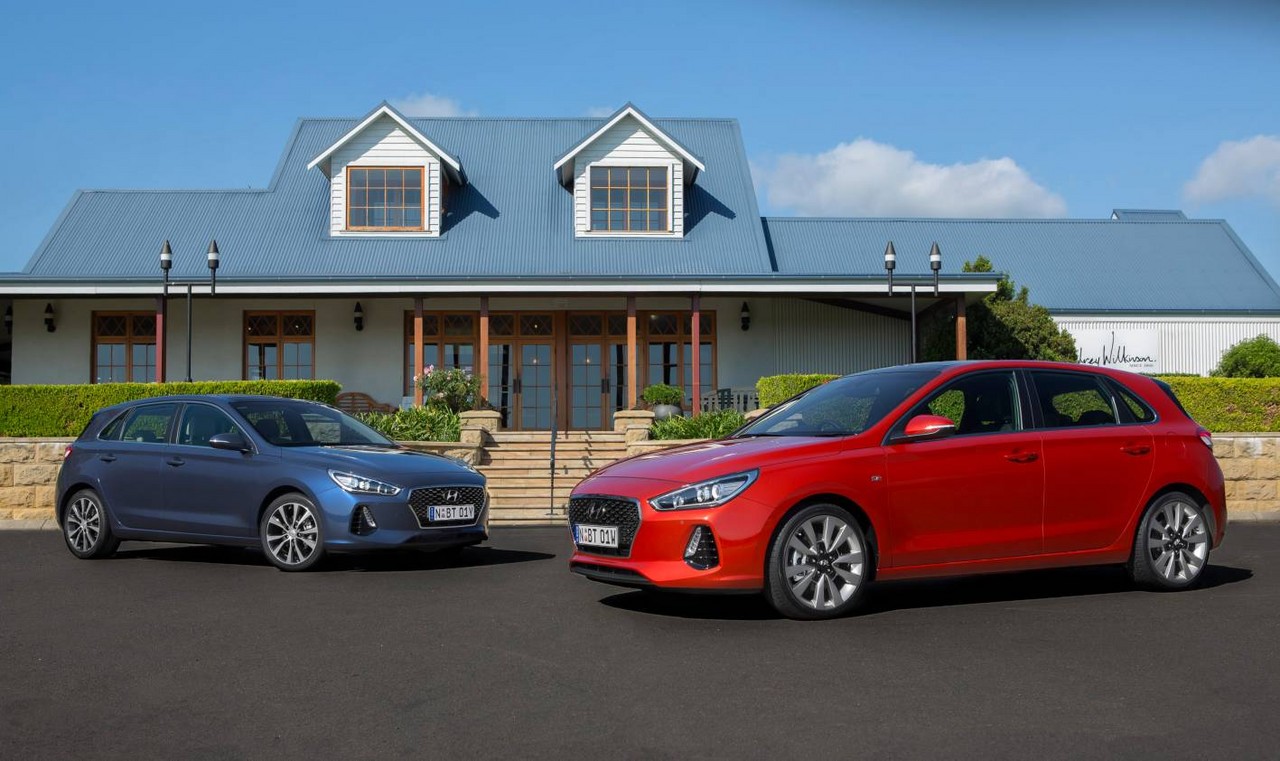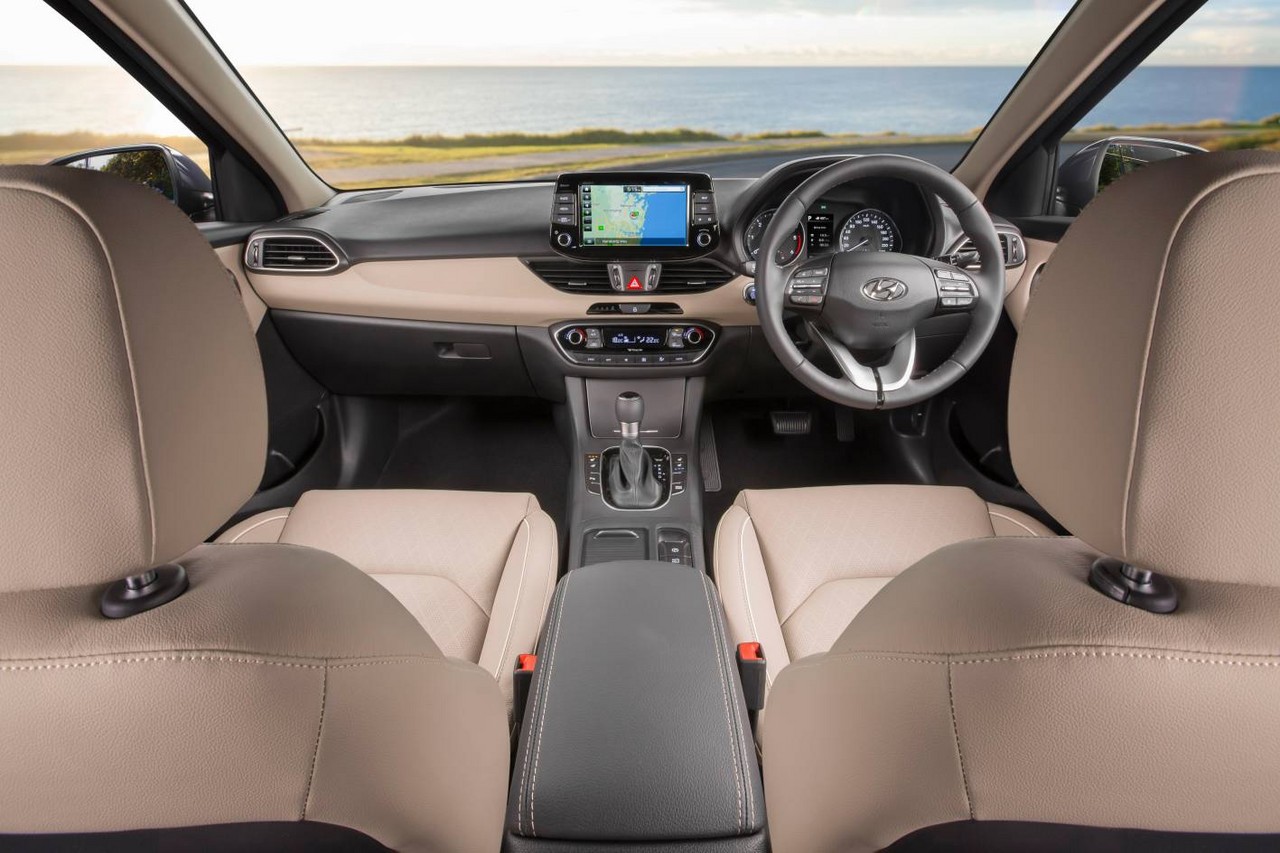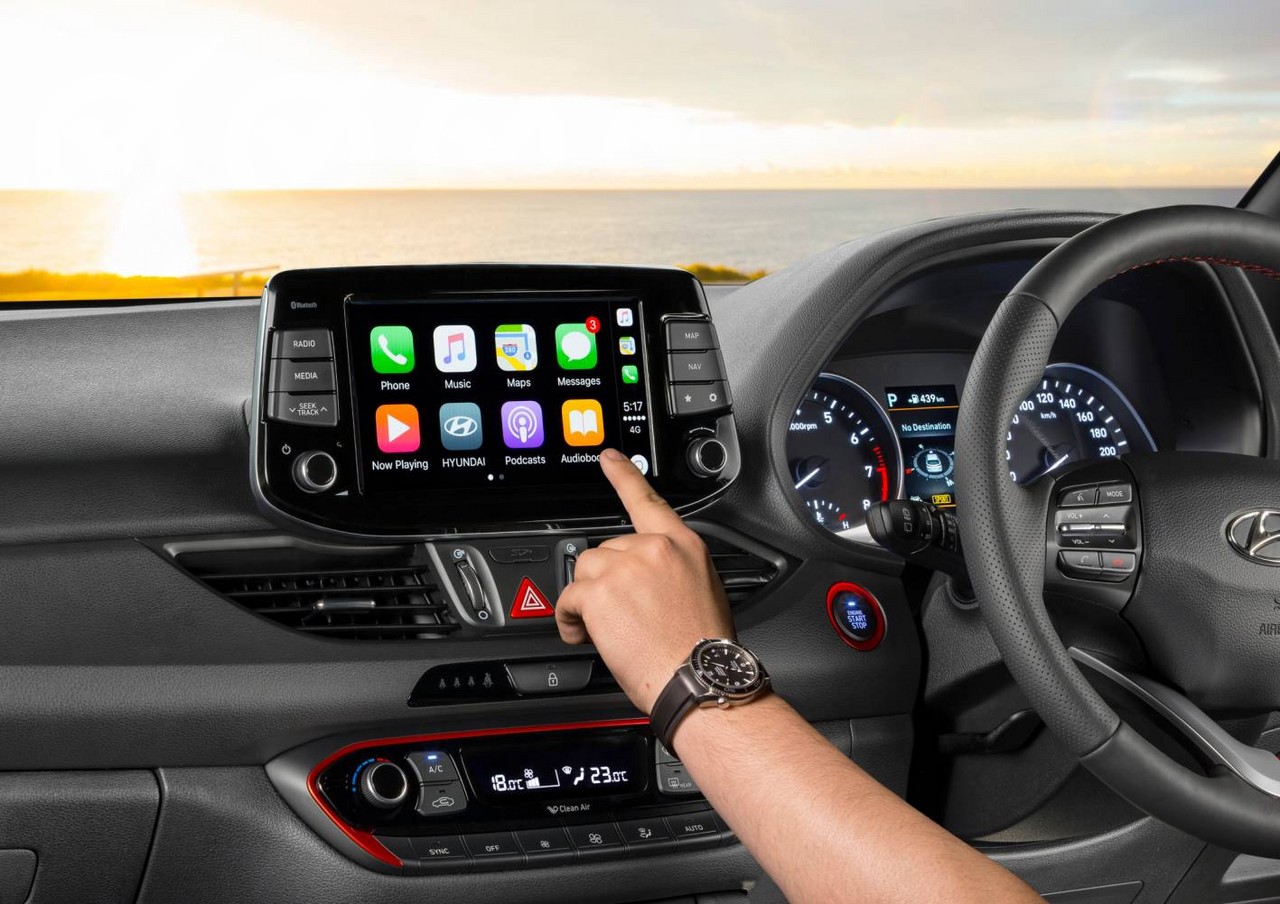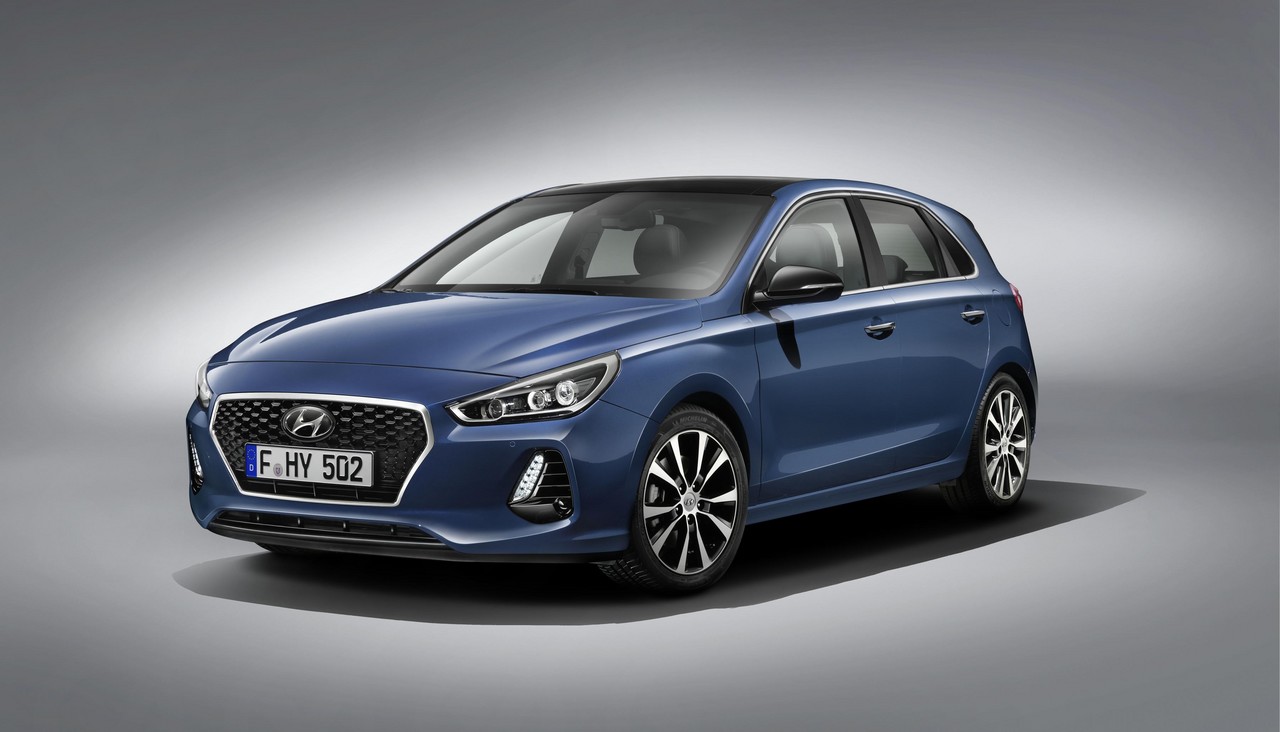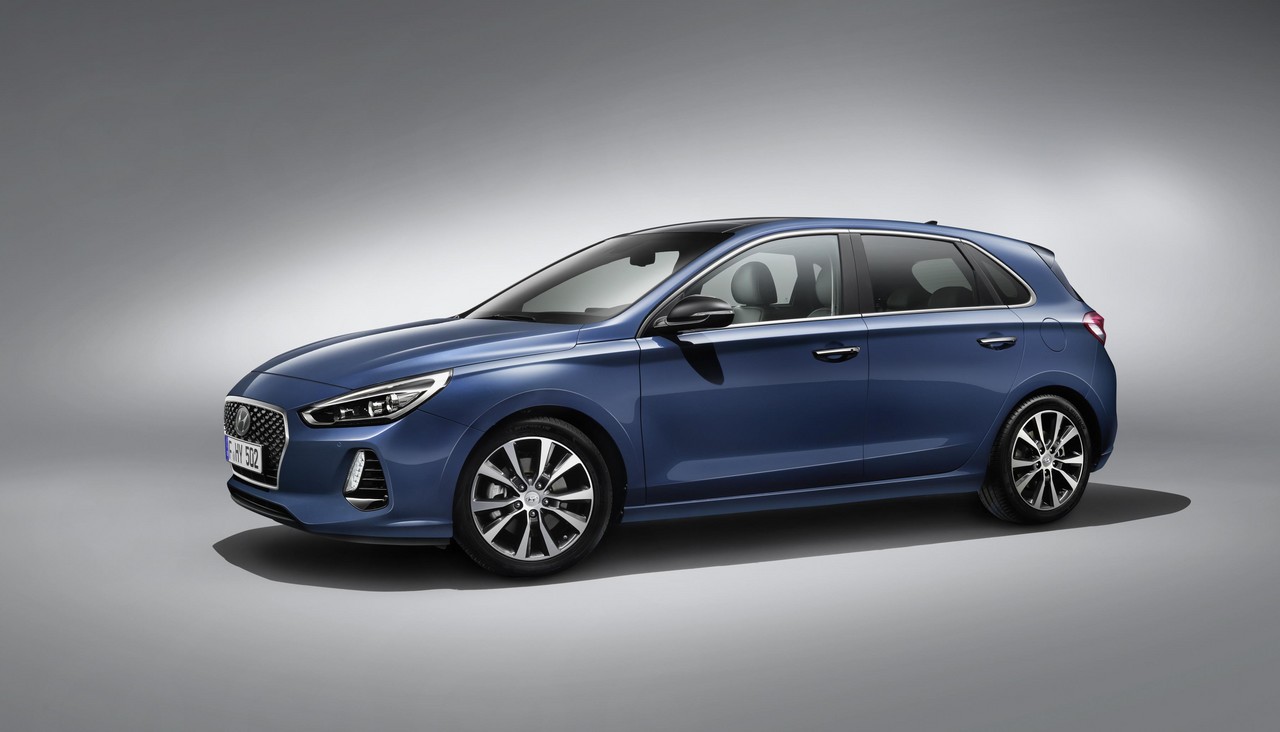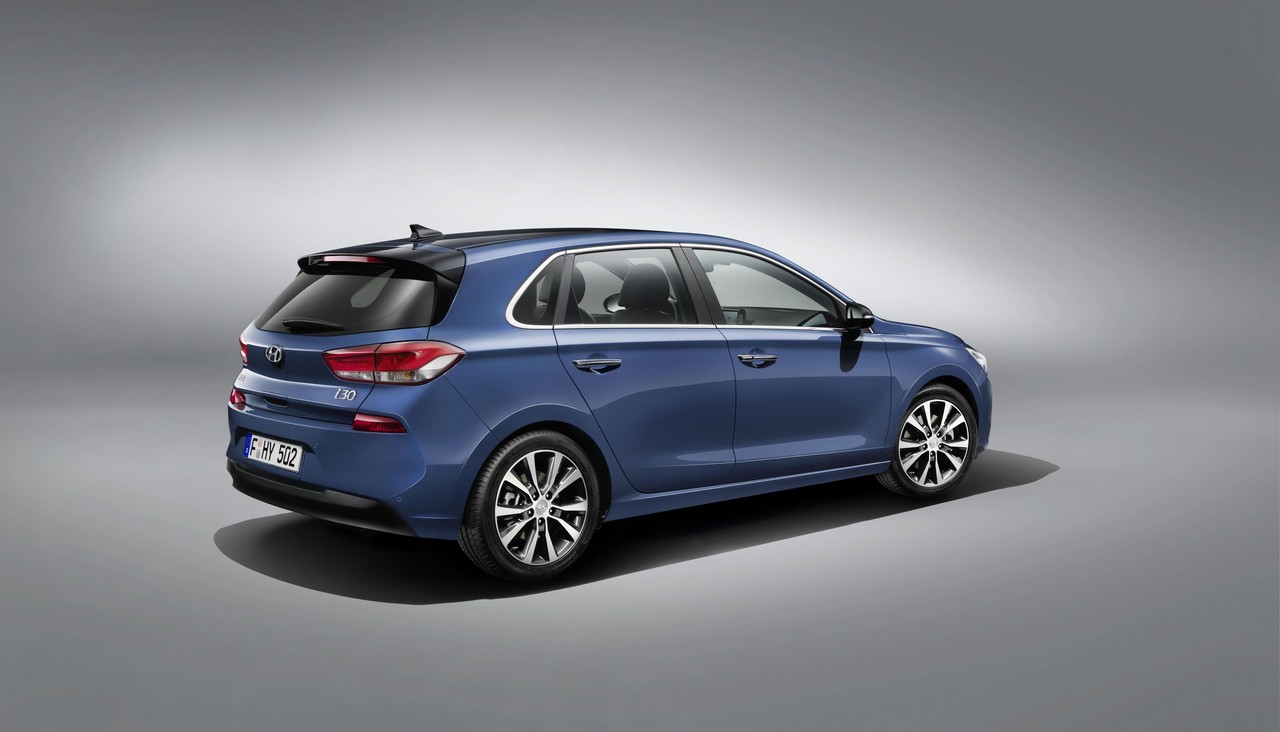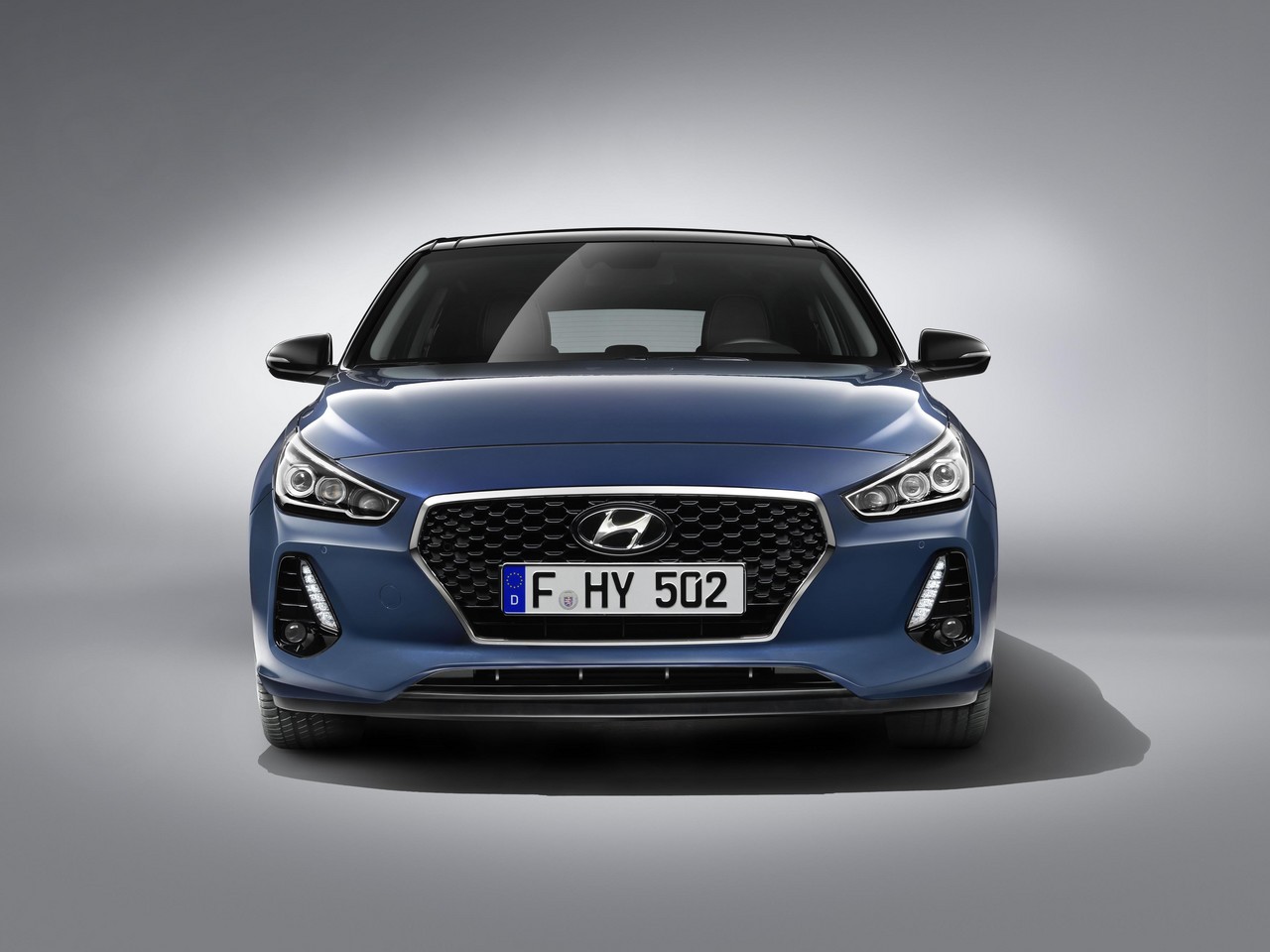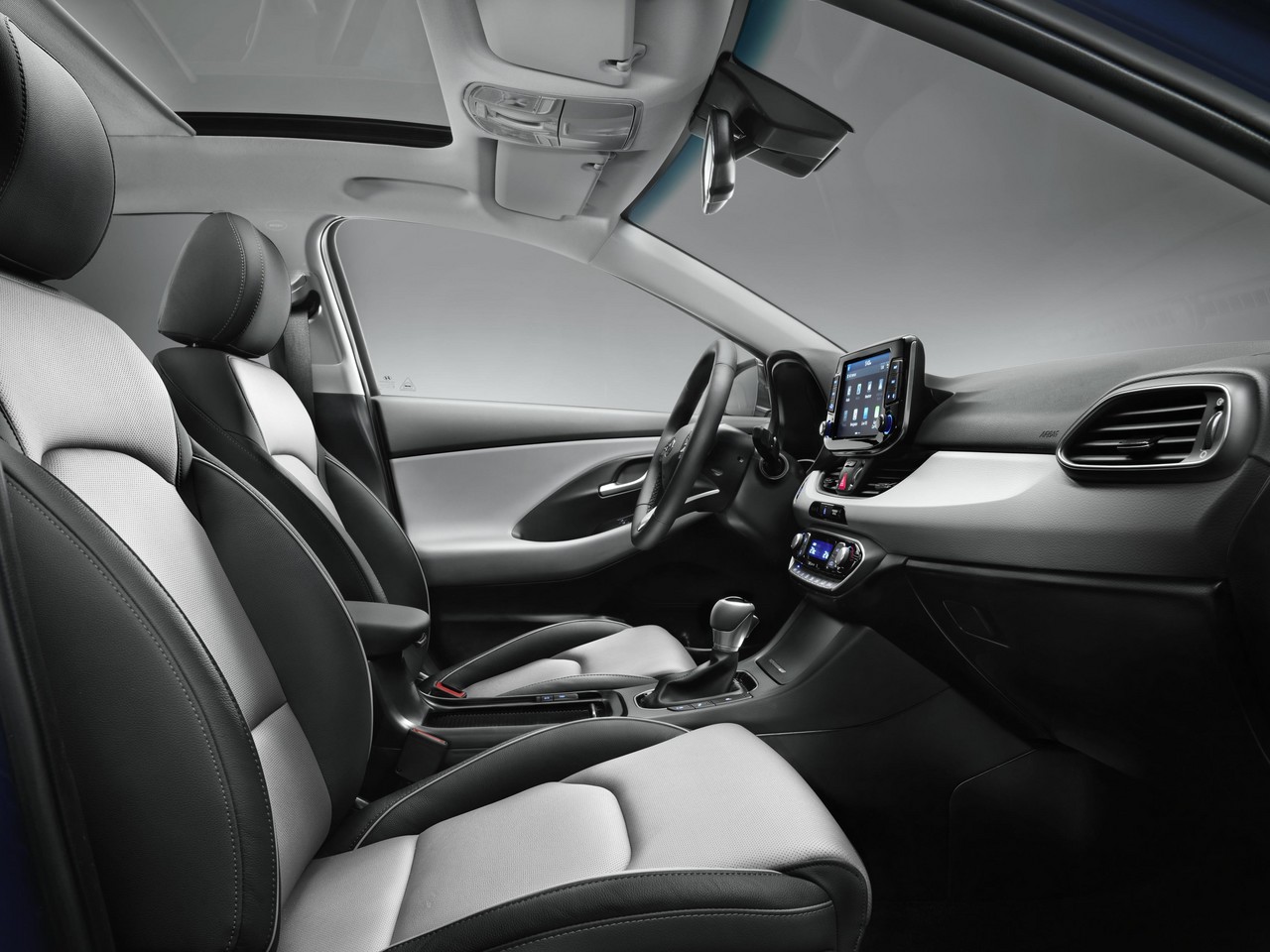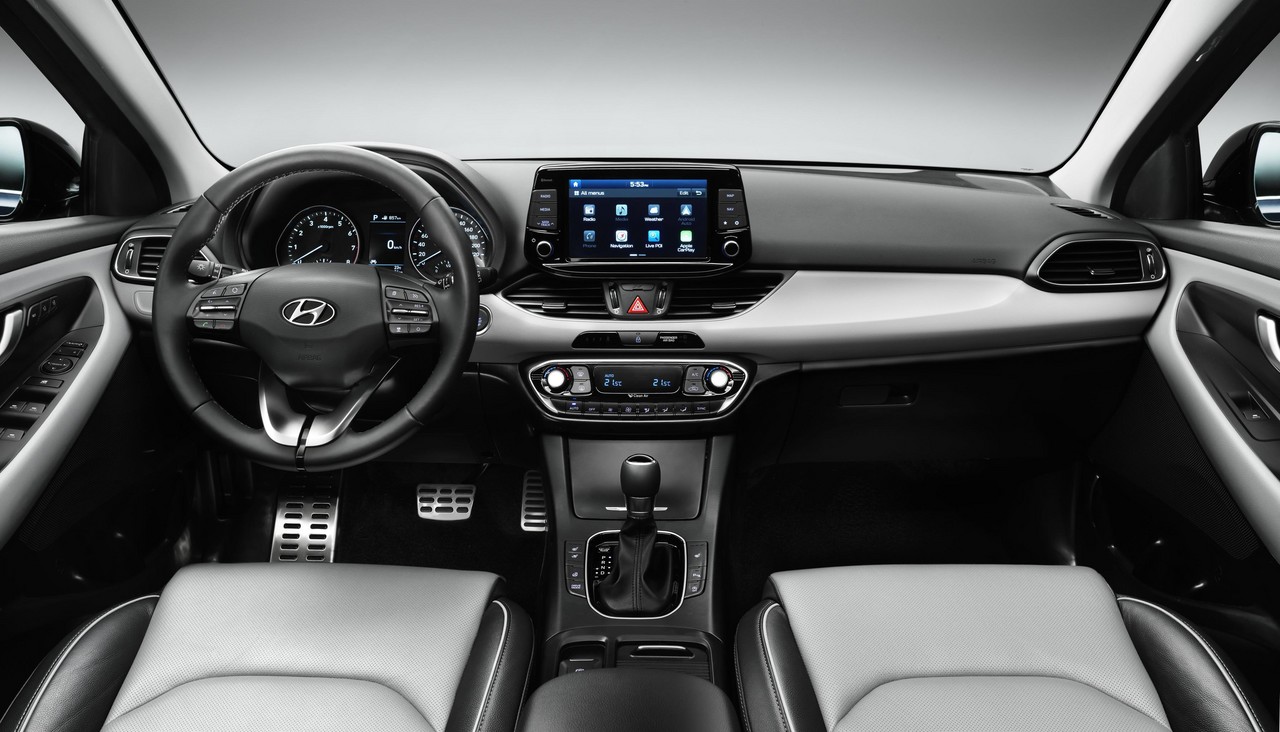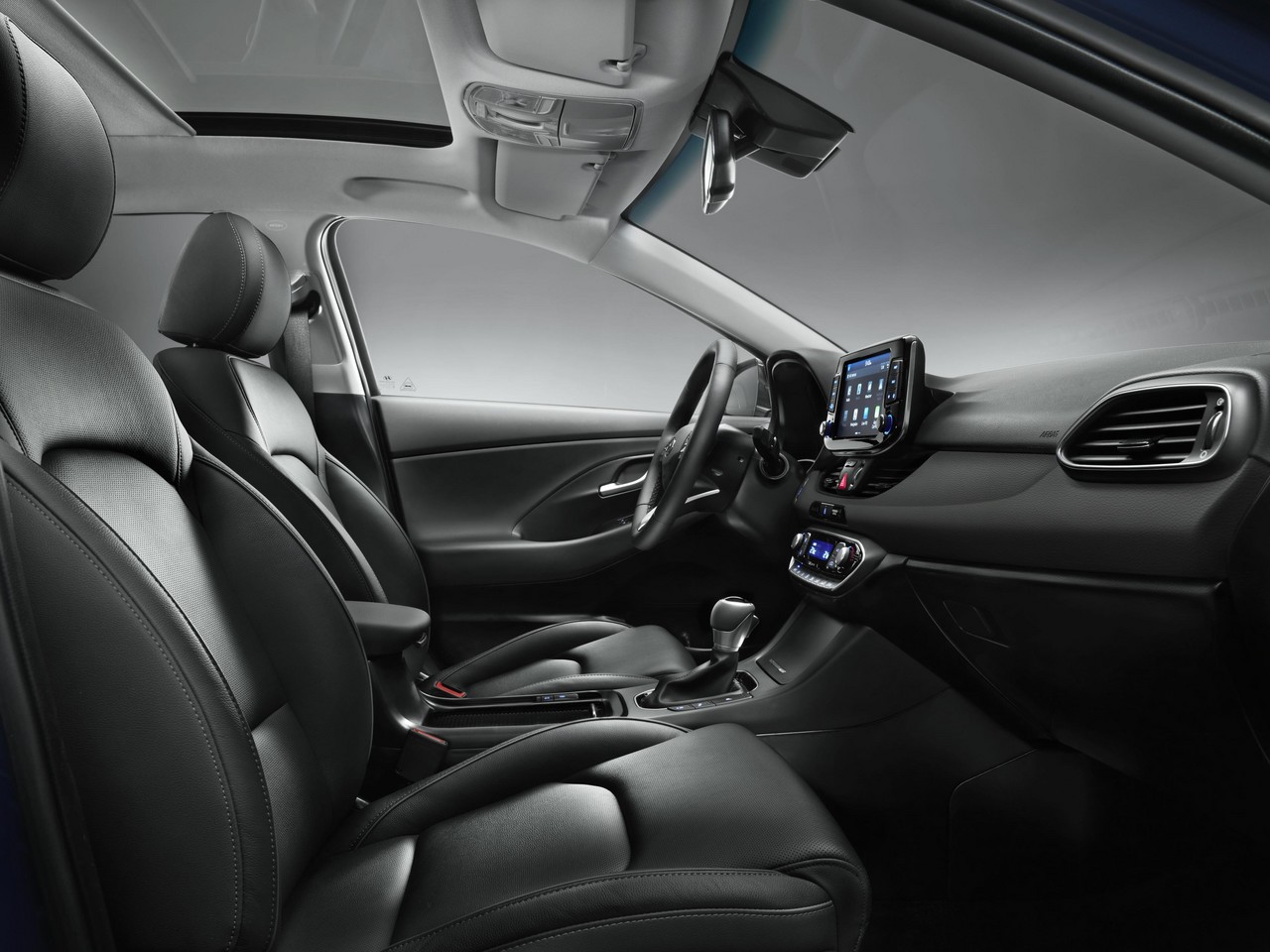
- Accomplished ride and handling balance
- Willing 1.6-litre turbocharged petrol engine
- Frugal 1.6-litre turbo-diesel engine
- i30 Active is generally well-equipped for its price…
- … but i30 Go and Active omit Autonomous Emergency Braking (AEB). Models with AEB retail for at least $8000 more (prior to April 2018 introduction of ‘SmartSense’ safety pack for $1750).
- Steering is heavy at low speeds and lacks feedback
- Mismatched interior plastics
- No rear air vents for i30 Go and Active
- For i30 SR, firm ride and road noise on coarse chip bitumen
Overview
Released in Australia in April 2017, the Hyundai PD i30 was a five-door, five-seat hatchback. Manufactured in Ulsan, South Korea, the front-wheel drive Hyundai PD i30 range initially consisted of 2.0 GDi, 1.6 T-GDi and 1.6 CRDi variants, and Active, Elite, Premium, SR and SR Premium editions (see table below). In December 2017, the entry-level Hyundai i30 Go was released and, in April 2018, the range was again expanded as the 2.0 GDi variant was offered in Elite and Premium editions.
In December 2018, the SR and SR Premium editions were replaced by the N Line and N Line Premium editions, respectively.
Hyundai PD i30: G4NC, G4FJ and D4FB engines
Of the engines,
- The i30 2.0 GDi was powered by the 2.0-litre G4NC petrol engine which was a member of Hyundai’s ‘Nu’ engine family and had an aluminium block and cylinder head, double overhead camshafts, four valves per cylinder, variable intake and exhaust cam timing (Hyundai’s ‘Dual Continuously Variable Valve Timing’ or D-CVVT), a two-stage variable induction system, direction injection and a compression ratio of 11.5:1;
- The i30 T-GDi was powered by Hyundai’s G4FJ ‘Gamma’ turbocharged petrol. While the Gamma engine had similar properties to the G4NC ‘Nu’ engine, it was fitted with a twin-scroll turbocharger, an air-guided intercooler and had a compression ratio of 9.5:1; and,
- For the i30 1.6 CRDi, the 1.6-litre D4FB ‘U-II’ turbo-diesel engine had a cast iron block, an aluminium cylinder head, a variable geometry turbocharger, double overhead camshafts, four valves per cylinder, common-rail direct injection and a compression ratio of 17.3:1.
| Variant | Engine | Trans. | Edition | Peak power | Peak torque |
|---|---|---|---|---|---|
| 2.0 GDi | 2.0-litre G4NC (Nu) petrol I4 | 6sp man., 6sp auto |
Go, Active |
120 kW at 6200 rpm | 203 Nm at 4700 rpm |
| 6sp auto | Elite, Premium (from 2018) |
||||
| 1.6 CRDi | 1.6-litre D4FB (U-II) turbo diesel I4 | 6sp man. | Go, Active |
100 kW at 4000 rpm | 280 Nm at 1500-3000 rpm |
| 7sp DCT | Go, Active, Elite, Premium |
100 kW at 4000 rpm | 300 Nm at 1750-2500 rpm | ||
| 1.6 T-GDi | 1.6-litre G4FJ (Gamma) turbo petrol I4 | 6sp man. | SR, N Line |
150 kW at 6000 rpm | 265 Nm at 1500-4500 rpm |
| 7sp DCT | SR, N Line, SR Premium, N Line Premium |
Body and dimensions
Compared to the Hyundai GD i30 which it replaced, the Hyundai PD i30 was 40 mm longer (at 4340 mm), 15 mm wider (1795 mm), 15 mm lower (1455 mm) and had a 100 mm longer wheelbase (2650 mm). Furthermore, the Hyundai PD i30 has a drag coefficient of 0.30 Cd, with aerodynamic features including an ‘Active Air Flap’ behind the front grille and ‘Air Curtains’ on each side of the front bumper to reduce turbulence in the wheel housing.
According to Hyundai, the body of the Hyundai PD i30 was 22 per cent more rigid than its predecessor; in part, this was due to:
- 53.5 per cent of the body being produced from Advanced High Strength Steel (up from 27.2 per cent for its predecessor);
- An increase in the length of structural adhesives to 112 metres (previously 92 metres); and,
- An improved hot stamping method which enabled the side outer reinforcement to be produced as a single component.
The Hyundai PD i30 has a luggage capacity of 395 litres, though this increased to 1301 litres when the rear seats were folded flat and luggage was filled to the roofline. The Hyundai PD i30 also had a two-stage luggage board and a ski hatch in the rear centre seat.
Suspension and steering
The Hyundai PD i30 had MacPherson strut front suspension. The rear suspension, however, differed between the variants –
- The 2.0 GDi and 1.6 CRDi had a torsion beam rear axle; and,
- The 1.6 T-GDi had multi-link rear suspension with a dual lower arm.
The Hyundai PD i30 had rack-and-pinion steering with electric power assistance (Hyundai’s ‘Column-mounted Motor Driven Power Steering, C-MDPS); the steering ratio of 13.4:1 meant that the steering wheel required 2.57 turns from lock-to-lock, while the Hyundai i30 had a turning circle of 10.6 metres.
Safety equipment
Standard safety equipment for the Hyundai PD i30 included dual front airbags, a driver’s knee airbag, front seat-mounted side airbags, full-length curtain airbags, ABS, electronic brake force distribution, brake assist, electronic stability control, traction control and front seatbelts with pre-tensioners and load limiters.
The Hyundai i30 Elite, Premium, SR with DCT and SR Premium were fitted with ‘Hyundai SmartSense’ which included the following technologies –
- Autonomous Emergency Braking (AEB) with Front Collision Warning System (FCWS): operating at speeds above 10 km/h, AEB with FCWS used a front radar sensor and camera sensors to monitor the road ahead for vehicles and pedestrians. AEB operated in three stages: initial warnings (visual and acoustic), partial braking and maximum braking when a collision was assessed to be imminent. AEB would attempt to bring the vehicle to rest if activated at speeds of up to 64 km/h for pedestrians and up to 80 km/h for vehicles. At speeds between 80 km/h and 180 km/h, AEB would reduce vehicle speed to reduce the severity of the collision;
- Blind Spot Detection (BSD) with Lane Change Assist (LCA): operated at speeds above 30 km/h and monitored the rear corners of the vehicle. If another vehicle was detected, a visual alert would appear in the door mirrors (BSD). Furthermore, an audible signal was emitted if the driver then activated the indicators to signal a lane change (LCA);
- Lane Keeping Assist System (LKAS): operating at speeds of 64 km/h and above, LKAS monitored the vehicle’s position within its lane. While the Lane Departure Warning System (LDWS) sounded an alarm before the vehicle crossed lane markings, LKAS provides acoustic and visual warnings before inducing corrective steering to guide the vehicle back to a safe position within its lane;
- Rear Cross Traffic Alert (RCTA): used radar sensors to scan a 180 degree area behind the vehicle for traffic that may cross the vehicle’s path as it is reversed out of a parking space. If detected, visual and acoustic signals would alert the driver;
- Smart Cruise Control (SCC): using front radar sensors, SCC enabled a constant speed and distance to be maintained from the vehicle ahead without depressing the accelerator or brake pedals. SCC was automatically cancelled when vehicle speed dropped to 10 km/h or below; and,
- Driver Attention Alert (DAA): operating at speeds of 64 km/h and above, DAA monitored steering angle, steering torque, vehicle position within its lane and driving pattern to detect reckless or fatigued driving. If the system detected inattentive driving patterns, an audible tone and message would appear on the instrument display panel to alert the driver. The driver could also adjust a setting for the system’s sensitivity.
The Hyundai i30 SR with manual transmission, however, was only fitted with Blind Spot Detection, Lane Change Assist and Rear Cross Traffic Alert.
From April 2018, the Hyundai i30 Go and Active could be specified with the SmartSense safety pack as a $1750 option. For the Hyundai i30 Go and Active, the SmartSense pack also included an electronic park brake, 4.2-inch TFT colour instrument cluster, rear cooling/heating vents, power folding door mirrors with LED side repeaters and a chrome front grille insert.
Euro NCAP testing
In Euro NCAP testing , the Hyundai PD i30 received a five star safety rating which included an 88 per cent adult occupant protection rating and an 84 per cent child occupant protection rating. In the frontal offset test, protection of the driver’s head and feet were rated as good, but chest and lower leg protection was rated as adequate (i.e. a slight risk of serious injury) and thigh protection as marginal (a moderate risk of serious injury) due to structures in the dashboard. In the side impact test, protection of the driver’s chest was rated as adequate; in the more severe pole test, chest protection was rated as marginal.
Brakes
The standard braking package for the Hyundai PD i30 consisted of 280 mm by 23 mm ventilated front brake discs and 262 mm by 10 mm solid rear discs. The i30 1.6 T-GDi, however, had 305 mm by 25 mm ventilated front brake discs and 284 mm by 10 mm solid rear discs.
Features: Hyundai i30 Go
Standard features for the Hyundai PD i30 Go included 6.5J x 16-inch steel wheels with 205/55 R16 tyres, a six speaker sound system, 3.5 mm auxiliary and USB inputs, an eight-inch touchscreen, Bluetooth mobile phone connectivity with audio streaming, Apple CarPlay and Android Auto smartphone integration, air conditioning, cruise control, projector beam headlights, front fog lights, LED daytime running lights, rear parking sensors, a rear view camera, dusk-sensing headlights, 60:40 split and folding rear seats, remote central locking, power adjustable and heated door mirrors, power windows, a height and reach adjustable steering wheel, a height adjustable driver’s seat, two 12 volt power sockets, illuminated vanity mirrors, tyre pressure monitoring, trip computer with a 3.5-inch TFT display and digital speedometer, an alarm and immobiliser.
As standard, the Hyundai i30 Go, Active, Elite and Premium were fitted with full-size spare wheels.
For Hyundai i30 models with automatic and double clutch transmissions, the driver could select from Normal, Eco and Sport drive modes which varied throttle pedal response, steering assistance and air conditioning output.
Features: Hyundai i30 Active
Relative to the Hyundai i30 Go, the i30 Active was further equipped with 6.5J x 16-inch alloy wheels with 205/55 R16 tyres, a digital radio tuner (DAB+), satellite navigation with SUNA live traffic updates, power folding door mirrors, a centre fold down armrest and cup holders in the rear fold-down armrest. From April 2018, the Hyundai i30 Active was equipped with a ‘leather appointed’ steering wheel and gear knob as standard.
Features: Hyundai i30 Elite
Compared to the i30 Accent, the i30 Elite was further equipped with 7.0J x 17-inch alloy wheels with 225/45 R17 tyres, leather appointed seats, dual-zone climate control air conditioning with ioniser, rain-sensing wipers, a leather-wrapped steering wheel and gearshift lever, proximity key (i.e. keyless entry), a height and reach adjustable steering wheel, push-button start, electronic parking brake, door handle courtesy lights, front centre armrest, mobile phone wireless charging pad (Qi standard) and trip computer with a 4.2-inch colour LCD.
Visually, the i30 Elite, Premium and SR editions could be identified by their chrome grille inserts.
Features: i30 Premium
Relative to the i30 Elite, the i30 Premium added a ten-way power adjustable driver’s seat, ventilated and heated front seats, LED headlights, front parking sensors, a panoramic glass sunroof with power-operated blind, solar control glass, an additional 12 volt power socket in the luggage compartment and a cloth headlining. From April 2018, the Hyundai i30 Premium was equipped with a seven speaker Infinity audio system that had an external amplifier.
Both the Hyundai i30 Premium and SR Premium had satin chrome door frame and beltline mouldings. From April 2018, the i30 Premium had LED tail lights.
Features: i30 SR and SR Premium
Compared to the i30 Active, Elite and Premium, the i30 SR and SR Premium both had 7.5J x 18-inch alloy wheels with 225/40 R18 tyres, front sports seats with extended bolsters, red stitching and piping (for the seats, steering wheel, front armrest and gearshift boot), metallic red inserts (for the air vents, start button, steering wheel and ventilation controls), alloy sports pedals, black headlining and, for models with double clutch transmissions, steering wheel gearshift paddles. Furthermore, visual cues for the i30 SR and SR Premium included LED tail-lights and dual chrome exhaust tips.
Beyond these distinguishing items, however, the i30 SR was similarly equipped to the i30 Elite, but omitted the electronic parking brake for models which had manual transmissions. The i30 SR Premium, however, had the additional features of the i30 Premium.
From April 2018, the Hyundai i30 SR Premium was equipped with a seven speaker Infinity audio system.
Features: i30 N Line and N Line Premium
Released in December 2018, the i30 N Line and N Line Premium editions replaced the SR and SR Premium editions, respectively. Within the PD i30 range, the N Line models could be identified by their 18-inch alloy wheels finished in ‘Hyper Silver’ with machined highlights (fitted with Michelin Pilot Sport 4 tyres), more aggressive front bumper with a silver lower insert, unique front grille, black headlight bezels, black door mirror caps, rear bumper with diffuser and silver lower insert, dual exhaust outlets, LED tail-lights and ‘N Line’ badges
Inside, the N Line models had black leather upholstery, front sports seats with carbon-fibre effect bolster trim and red stitching and piping, an ‘N Line’ sports steering wheel and gear knob, red highlights (for the gear knob, outer air vents, front seatbelts and rear outer seatbelts), black headlining, ‘Dark Metal’ inserts for the steering wheel and door handles.
While the i30 N Line and N Line Premium were fitted with ‘Hyundai Auto Link’ and ‘Hyundai Auto Link Premium’, respectively, features were otherwise the same as the SR and SR Premium editions.
Specifications
- Specifications: Hyundai PD i30 (April 2017)
- Specifications: Hyundai PD i30 (December 2017)
- Specifications: Hyundai PD i30 (April 2018)
- Specifications: Hyundai PD i30 (December 2018)
